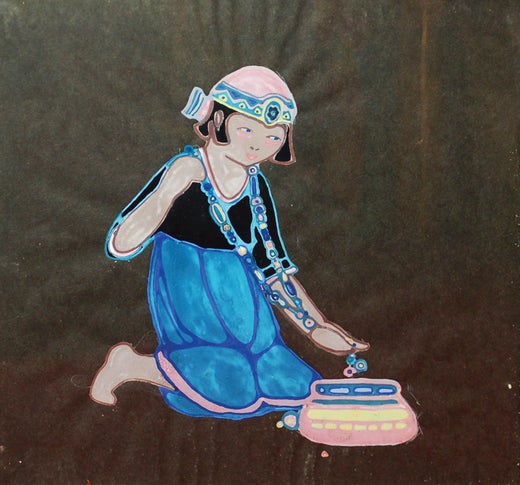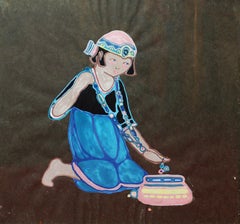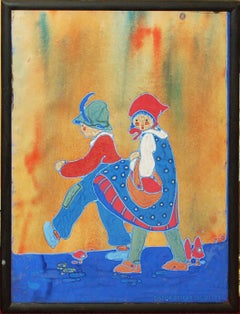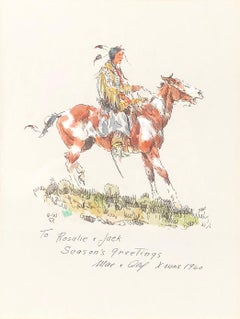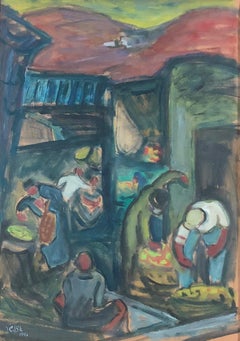Want more images or videos?
Request additional images or videos from the seller
1 of 5
Gisella LoefflerThree Girlsc. 1919
c. 1919
$2,300List Price
About the Item
- Creator:Gisella Loeffler (1902 - 1977, American, Austrian)
- Creation Year:c. 1919
- Dimensions:Height: 19 in (48.26 cm)Width: 13 in (33.02 cm)Depth: 0.5 in (1.27 cm)
- Medium:
- Movement & Style:
- Period:
- Condition:
- Gallery Location:Missouri, MO
- Reference Number:1stDibs: LU74733212453
Gisella Loeffler
Born in Austria, Gisella came to the United States with her family in 1908, settling in St. Louis, MO. After studying art at Washington University in St. Louis, she became a prominent member of the local art community, joining the St. Louis Art Guild as well as the Boston Society of Arts and Crafts. In addition to creating posters for the St. Louis Post Dispatch, Gisella won prizes from the Artists Guild of the Author’s League of America in 1919 and 1920 and from the Kansas City Art Institute in 1923. She also began working in textiles, including batik, to which she would return later in her career. Having seen a local exhibition of paintings by Taos artists Oscar Berninghaus (who was from St. Louis) and Ernest Blumenschein, Gisella felt drawn to Taos, which reminded her of the villages of her native Austria. In 1933 the single mother with two daughters, Undine and Aithra, moved to Taos, where she lived off and on for the rest of her life. She traveled frequently, spending extended periods in Mexico, South America, and California, but always returned to New Mexico. Gisella initially applied an Austro-Hungarian folk-art style to the Indian and Hispanic subjects that she found in New Mexico. In her early work she covered her surfaces with decorative floral and faunal motifs, and her images were flat with no attempt at rendering traditional one-point perspective. Eventually, though, Gisella developed her own style, often using children or childlike figures as subjects. Still, the influence of her native country’s folk art remained evident in her New Mexican, Mexican, and South American images. In California, Gisella broadened her range of artistic pursuits. She taught art privately, created illustrations for Scripts Magazine, and did interior design for private homes. She also designed greeting cards, a practice she continued after her return to New Mexico, where she created a series of Christmas cards. Gisella began illustrating children’s books in 1941 when she collaborated on Franzi and Gizi with author Margery Bianco. Eventually she wrote and illustrated her own book, El Ekeko, in 1964. She also designed ceramics—her Happy Time Dinnerware, marketed by Poppy Trail and manufactured by Metlox of Manhattan Beach, CA, is highly collectible today. As a painter, she worked on canvas or paper in oil, casein, and watercolor. She also painted furniture. Besides making her own clothing, Gisella worked in other fabric arts such as batik and embroidery. In fact, she received the top award in fabric arts in 1959 and again in 1967 from the Mus-eum of International Folk Art in Santa Fe. But perhaps Gisella’s greatest legacy is the murals she painted for children’s areas in hospitals across the United States. Gisella’s death in 1977 left a large hole in the fabric of the Taos Art Colony and the entire Taos community. Yet her work, so colorful and full of joy, remains an uplifting presence in Taos.
About the Seller
5.0
Vetted Professional Seller
Every seller passes strict standards for authenticity and reliability
Established in 1970
1stDibs seller since 2017
155 sales on 1stDibs
Typical response time: Several days
Authenticity Guarantee
In the unlikely event there’s an issue with an item’s authenticity, contact us within 1 year for a full refund. DetailsMoney-Back Guarantee
If your item is not as described, is damaged in transit, or does not arrive, contact us within 7 days for a full refund. Details24-Hour Cancellation
You have a 24-hour grace period in which to reconsider your purchase, with no questions asked.Vetted Professional Sellers
Our world-class sellers must adhere to strict standards for service and quality, maintaining the integrity of our listings.Price-Match Guarantee
If you find that a seller listed the same item for a lower price elsewhere, we’ll match it.Trusted Global Delivery
Our best-in-class carrier network provides specialized shipping options worldwide, including custom delivery.You May Also Like
Original 70's Hand Painted Textile Design Gouache Green Blue Color on Grey Pape
Located in ALCOY/ALCOI, ES
Flower bouquet design. Sealed on the back with the design studio name and number 484
We offer a small number of these original illustration designs by this design studio based in Al...
Category
1970s Modern Still-life Prints
Materials
Paper, Gouache
$1,022
H 34.65 in W 18.9 in D 0.12 in
Paul JOUVE (1878-1973), "The Camel Riders"
By Paul Jouve
Located in Paris, FR
Paul Jouve was a French illustrator and sculptor, passionate about animals from a young age, which he discovered at the Natural History Museum and in Parisian zoos. He is the most fa...
Category
1930s Modern Figurative Drawings and Watercolors
Materials
Paper, India Ink, Gouache, Pencil
Cyclistes devant jardin et bosquet
By Gen Paul
Located in PARIS, FR
Gouache on paper
Signed lower right
Provenance:
- France, Private collection.
Category
Mid-20th Century Modern Figurative Drawings and Watercolors
Materials
Gouache
BYE BYE BIRDIE Original 1960 Broadway Musical Costume Drawing Tony Award Elvis
Located in New York, NY
BYE BYE BIRDIE Original 1960 Broadway Musical Costume Drawing Tony Award Elvis
Miles White (1915 – 2000)
BYE BYE BIRDIE
11 x 8 inches
Mixed Media on Paper
Signed Lower Right
Framed by Bark
Affixed to the back are original gold lame fabric swatches.
This drawing is available, along with two other original costume drawings from BIRDIE by Miles White, another of Conrad Birdie and one of Chita Rivera.
Miles White, a leading Broadway and Hollywood costume designer for decades. created costumes for the original Broadway productions of OKLAHOMA CAROUSEL, BYE BYE BIRDIE and many others.
In film he worked on "Around the World in 80 Days" and "The Greatest Show on Earth." He designed Ringling Bros and Barnum & Bailey Circus, and the Ice Capades for many years.
Miles was a close friend for the last 20 years of his life. We live with one of his two Tony Awards and a dozen drawings.
BYE BYE BIRDIE is a stage musical with music by Charles Strouse and lyrics by Lee Adams, based upon a book by Michael Stewart...
Category
1960s American Modern Figurative Drawings and Watercolors
Materials
Watercolor, Gouache, Pencil
$12,000
H 16 in W 13 in D 1 in
Magazine Cover Illustration Mid 20th Century Modern Theatre Broadway Realism WPA
By Ernest Hamlin Baker
Located in New York, NY
Magazine Cover Illustration Mid 20th Century Modern Theatre Broadway Realism WPA
Ernest Hamlin Baker (1889 – 1975) “Today Magazine” Cover ...
Category
1930s American Modern Figurative Drawings and Watercolors
Materials
Gouache, Paper, Watercolor, Ink
$7,500
H 24 in W 20 in D 2 in
Original Painting. Vanity Fair Illustration Proposal. Art Deco Modern 1930s
By Antonio Petruccelli
Located in New York, NY
Original Painting. Vanity Fair Illustration Proposal. Art Deco Modern 1930s
Antonio Petruccelli (1907 - 1994)
Vanity Fair
Illustration proposal, c 1930’s
18 X 13 3/4 inches (sight)
...
Category
1930s American Modern Figurative Paintings
Materials
Gouache, Board
Original Painting. New Yorker Mag Cover Proposal WPA Mid Century American Scene
By Antonio Petruccelli
Located in New York, NY
Original Painting. New Yorker Mag Cover Proposal WPA Mid Century American Scene
Antonio Petruccelli (1907 – 1994)
Perplexed Gentleman
New Yorker cover proposal, c. 1939
13 1/4 X 8 ...
Category
1930s American Modern Figurative Paintings
Materials
Gouache, Board
BYE BYE BIRDIE Original 1960 Broadway Musical Costume Drawing Tony Award Elvis
Located in New York, NY
BYE BYE BIRDIE Original 1960 Broadway Musical Costume Drawing Tony Award Elvis.
Miles White (1915 – 2000)
BYE BYE BIRDIE
11 x 8 inches
Mixed Media on...
Category
1960s American Modern Figurative Drawings and Watercolors
Materials
Watercolor, Gouache, Pencil
$12,000
H 22 in W 18 in D 1 in
“Woman in Blue”
By Kenneth Paul Block
Located in Southampton, NY
Here for your consideration is an original watercolor and gouache fashion illustration by the world renowned fashion artist, Kenneth Paul Block. Presently unframed. Signed with initi...
Category
1960s American Modern Figurative Drawings and Watercolors
Materials
Watercolor, Gouache, Archival Paper
Secret. 2023, gouache, paper, 12, 5 x 13 cm
Located in Riga, LV
Secret. 2023, gouache,, paper, 12,5 x 13 cm
Ansis Butnors (1977)
Education:
J. Rozentals Art School in Riga – 1989. – 1996.
Latvian Academy of Art, Painting Department – 1996. – 2...
Category
2010s Modern Figurative Paintings
Materials
Paper, Gouache
More From This Seller
View AllThe Necklace and the Pot
By Gisella Loeffler
Located in Missouri, MO
Gisella Loeffler
"The Necklace and the Pot" c. 1919
Gouache on Paper
Initialed Lower Left
Framed Size: approx 15 x 15 inches
In a village filled with colorful characters, few Taos artists were as colorful as Gisella Loeffler [1900-1977]. From her handmade Austrian clothing and hand-painted furniture to whimsical paintings and letters written in multicolored crayon, joyful color defined the artist, who early on chose to use simply Gisella as her professional name and was known as such to everyone in Taos.
In spite of her fame there—the Taos News once labeled her a Taos legend—Gisella is rarely included in scholarly discussions of the Taos Art Colony. This oversight is likely due to the naive quality of her work, in which children or childlike adults inhabit a simple, brightly colored world filled with happiness. The macabre, the sad, the tortured, the offensive—all have no place in Gisella’s paintings. Her naive style of work looks very different from that of the better-known early Taos artists. Yet both Gisella’s artwork and her interesting life command attention.
Born in Austria, Gisella came to the United States with her family in 1908, settling in St. Louis, MO. After studying art at Washington University in St. Louis, she became a prominent member of the local art community, joining the St. Louis Art Guild as well as the Boston Society of Arts and Crafts. In addition to creating posters for the St. Louis Post Dispatch, Gisella won prizes from the Artists Guild of the Author’s League of America in 1919 and 1920 and from the Kansas City Art Institute in 1923. She also began working in textiles, including batik, to which she would return later in her career.
In the early 1920s Gisella married writer and music critic Edgar Lacher. A difficult character, Lacher may have chafed under Gisella’s success, for the couple divorced in the 1930s.
Having seen a local exhibition of paintings by Taos artists Oscar Berninghaus (who was from St. Louis) and Ernest Blumenschein, Gisella felt drawn to Taos, which reminded her of the villages of her native Austria. In 1933 the single mother with two daughters, Undine and Aithra, moved to Taos, where she lived off and on for the rest of her life. She traveled frequently, spending extended periods in Mexico, South America, and California, but always returned to New Mexico.
Gisella initially applied an Austro-Hungarian folk-art style to the Indian and Hispanic subjects that she found in New Mexico. In her early work she covered her surfaces with decorative floral and faunal motifs, and her images were flat with no attempt at rendering traditional one-point perspective. Eventually, though, Gisella developed her own style, often using children or childlike figures as subjects. Still, the influence of her native country’s folk art remained evident in her New Mexican, Mexican, and South American images.
In 1938 Gisella moved briefly to Los Griegos, north of Albuquerque, to be closer to medical facilities for her eldest daughter, who was suffering from rheumatic fever. Two years later, she moved to California to participate in the war effort, painting camouflage and decals on airplanes for Lockheed.
In California, Gisella broadened her range of artistic pursuits. She taught art privately, created illustrations for Scripts Magazine, and did interior design for private homes. She also designed greeting cards, a practice she continued after her return to New Mexico, where she created a series of Christmas cards.
Gisella began illustrating children’s books in 1941 when she collaborated on Franzi and Gizi with author Margery Bianco. Eventually she wrote and illustrated her own book, El Ekeko, in 1964. She also designed ceramics—her Happy Time Dinnerware, marketed by Poppy Trail...
Category
1910s Modern Figurative Drawings and Watercolors
Materials
Gouache
Price Upon Request
Going for a Stroll
By Gisella Loeffler
Located in Missouri, MO
Gisella Loeffler
"Going for a Stroll" c. 1919
Gouache on Paper
Initialed
Framed Size: approx 17 x 13 inches
In a village filled with colorful characters, few Taos artists were as colorful as Gisella Loeffler [1900-1977]. From her handmade Austrian clothing and hand-painted furniture to whimsical paintings and letters written in multicolored crayon, joyful color defined the artist, who early on chose to use simply Gisella as her professional name and was known as such to everyone in Taos.
In spite of her fame there—the Taos News once labeled her a Taos legend—Gisella is rarely included in scholarly discussions of the Taos Art Colony. This oversight is likely due to the naive quality of her work, in which children or childlike adults inhabit a simple, brightly colored world filled with happiness. The macabre, the sad, the tortured, the offensive—all have no place in Gisella’s paintings. Her naive style of work looks very different from that of the better-known early Taos artists. Yet both Gisella’s artwork and her interesting life command attention.
Born in Austria, Gisella came to the United States with her family in 1908, settling in St. Louis, MO. After studying art at Washington University in St. Louis, she became a prominent member of the local art community, joining the St. Louis Art Guild as well as the Boston Society of Arts and Crafts. In addition to creating posters for the St. Louis Post Dispatch, Gisella won prizes from the Artists Guild of the Author’s League of America in 1919 and 1920 and from the Kansas City Art Institute in 1923. She also began working in textiles, including batik, to which she would return later in her career.
In the early 1920s Gisella married writer and music critic Edgar Lacher. A difficult character, Lacher may have chafed under Gisella’s success, for the couple divorced in the 1930s.
Having seen a local exhibition of paintings by Taos artists Oscar Berninghaus (who was from St. Louis) and Ernest Blumenschein, Gisella felt drawn to Taos, which reminded her of the villages of her native Austria. In 1933 the single mother with two daughters, Undine and Aithra, moved to Taos, where she lived off and on for the rest of her life. She traveled frequently, spending extended periods in Mexico, South America, and California, but always returned to New Mexico.
Gisella initially applied an Austro-Hungarian folk-art style to the Indian and Hispanic subjects that she found in New Mexico. In her early work she covered her surfaces with decorative floral and faunal motifs, and her images were flat with no attempt at rendering traditional one-point perspective. Eventually, though, Gisella developed her own style, often using children or childlike figures as subjects. Still, the influence of her native country’s folk art remained evident in her New Mexican, Mexican, and South American images.
In 1938 Gisella moved briefly to Los Griegos, north of Albuquerque, to be closer to medical facilities for her eldest daughter, who was suffering from rheumatic fever. Two years later, she moved to California to participate in the war effort, painting camouflage and decals on airplanes for Lockheed.
In California, Gisella broadened her range of artistic pursuits. She taught art privately, created illustrations for Scripts Magazine, and did interior design for private homes. She also designed greeting cards, a practice she continued after her return to New Mexico, where she created a series of Christmas cards.
Gisella began illustrating children’s books in 1941 when she collaborated on Franzi and Gizi with author Margery Bianco. Eventually she wrote and illustrated her own book, El Ekeko, in 1964. She also designed ceramics—her Happy Time Dinnerware, marketed by Poppy Trail...
Category
1910s Modern Figurative Drawings and Watercolors
Materials
Gouache
Price Upon Request
Season's Greetings 1960 (Brave on Horseback)
By Olaf Wieghorst
Located in Missouri, MO
Olaf Wieghorst (American, 1899-1988)
"Season's Greetings" (Brave on Horseback) 1960
Watercolor/Gouache on Paper
Initialed and Monogramed and Dated
Dedicated: "To Rosalie & Jack, Season's Greetings, Mae & Olaf Xmas 1960"
Site Size: 12 x 9 inches
Framed Size: approx. 22.5 x 18.5 inches
Born in Viborg, Denmark, Olaf Wieghorst was a child acrobatic performer from the age of nine when he began appearances at Tivoli Theater in Copenhagen and later toured Europe. He also learned horseback riding working on a stock farm, and horses became a major focus of his admiration and later his painting.
In 1918, he arrived in the United States, having worked as a cabin boy on a steamer. He served in the 5th U.S. Cavalry on the Mexican border in the days of Pancho Villa...
Category
1960s American Realist Figurative Drawings and Watercolors
Materials
Paper, Watercolor, Gouache
Price Upon Request
The Village Market
By Jacob Eisenscher
Located in Missouri, MO
Jacob (Yaacov) Eisenscher
"The Village Market" 1947
Gouache/Watercolor on Paper
Signed and Dated Lower Left
Image Size: approx 18 x 12.5
Framed Size: approx 27 1/8 x 22 1/4 inches
...
Category
1940s Realist Figurative Drawings and Watercolors
Materials
Paper, Gouache
Price Upon Request
Golf Bags, Caddy with Golf Bag on His Back
By Frederick Conway
Located in Missouri, MO
Framed Size: approx 17 3/4 x 20 3/4 inches
Fred Conway (1900-1973)
"Golf Bags, Caddy with Golf Bag on His Back"
Pen/Ink/Watercolor on Paper
Site Size: approx. 10 x 13 inches
Framed Size: approx. 17 3/4 x 20 3/4 inches
A member of the faculty of the Washington University Art School from 1929 to 1970, Frederick Conway...
Category
1960s American Modern Figurative Drawings and Watercolors
Materials
Paper, Ink, Watercolor, Pen
Golfers
By Frederick Conway
Located in Missouri, MO
Golfers, 1928
Fred Conway (American, 1900-1973)
Signed and Dated Lower Right
18.5 x 24.5 inches
30.5 x 37 inches with frame
A member of the faculty of the Washington University Art ...
Category
1920s American Modern Figurative Drawings and Watercolors
Materials
Paper, Watercolor
Price Upon Request
